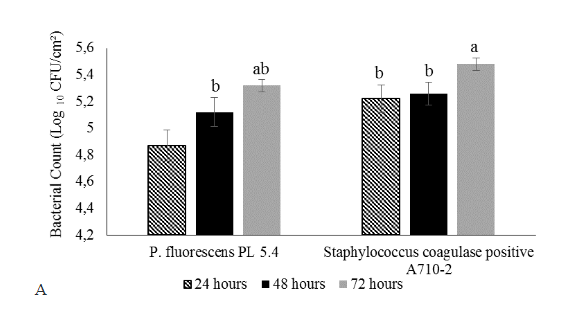Evaluation of the adhesion potential of psychrotrophic bacteria isolated from refrigerated raw buffalo milk: Simulating storage conditions
Keywords:
Bubalus bubalis, buffaloes, bacteria, adhesion, biofilm, contamination, PseudomonasAbstract
The aim of this study was to evaluate the in vitro adhesion potential of psychrotrophic bacteria isolated from buffalo milk. The biofilm formation was evaluated on stainless steel and on a polypropylene surface at temperatures of 7oC, 23oC and 30oC for 24, 48 and 72 h. They were also tested for adhesion to stainless steel at 7oC, in sterilized milk buffalo. Other tests on stainless steel were conducted with the adhesive strains, in co-cultivation with the Staphylococcus coagulase positive A710-2 strain. The co-culture was tested in sterilized buffalo whole milk on a stainless steel surface at 7oC. Isolates were identified by 16S rRNA gene sequencing in order to consider Pseudomonas fluorescens PL5.4 e Pseudomonas fluorescens PL7.1. These psychrotrophic bacteria were able to adhere under the conditions tested, with biofilm cell counts exceeding 5.65 and 6.16 log CFU/cm2 on stainless steel and 6.3 and 6.37 log CFU/cm2 on polypropylene, for P. fluorescens PL5.4 and P. fluorescens PL7.1 respectively. Both strains showed higher adhesion to a polypropylene. Regarding the test for stainless steel adhesion, at 7oC in sterilized buffalo milk, the tested strains showed counts of 4.85 and 5.09 log CFU/cm2 for P. fluorescens PL5.4 and P. fluorescens PL7.1 respectively. Both psychrotrophic strains were able adhere in co-culture with the Staphylococcus coagulase positive A710-2 strain. This study shows that psychrotrophic bacteria, originally isolated from refrigerated raw buffalo milk, can adhere to stainless steel and polypropylene surfaces at different temperatures, indicating that once present in milk, they may become a source of recontamination.
Downloads
Metrics





.png)








